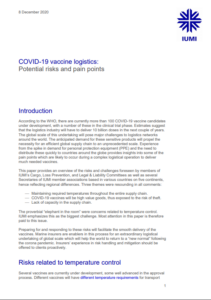The recent events within the whole world in regards to the pandemic have seen a positive side, with the vaccine launch. Now, as the industry is focusing on how the vaccine will work and who will be in priority, IUMI launched a paper providing guidance of the risks and challenges.
According to the WHO, there are currently more than 100 COVID-19 vaccine candidates under development, with a number of these in the clinical trial phase.
Accordingly, three themes were resounding in all comments:
- Maintaining required temperatures throughout the entire supply chain.
- COVID-19 vaccines will be high value goods, thus exposed to the risk of theft.
- Lack of capacity in the supply chain.
IUMI emphasizes to what they believe will be the biggest challenge; temperature control. Most attention in this paper is therefore paid to this issue.
Risks
Temperature control
#1 Different vaccines will have different temperature requirements for transport and storage. It remains to be seen how many of the approved products will necessitate temperatures as low as -80°C for safe transport and storage.
Some vaccines may fall into the cold chain or refrigerated goods range of +2 to 8°C for transport and storage which would simplify the distribution as this range is common to pharmaceutical products. Given the expeditious development of the vaccines, insufficient stability data might however lead to strict temperature requirements throughout the entire supply chain.
Thus, it is noted that the use of real time tracking and temperature monitoring throughout the course of transit should be in place, e.g. with established escalation protocol, including immediate notification of appropriate carrier points of contact in the event of a temperature deviation or delay in transit.
Regulation
#2 Another risk would be the different regulatory regimes, that eventually will have to be adhered to during the entire logistics chain.
Insufficient cooling options
#3 Insufficient cooling capabilities of cold storage warehouses, sea containers, road transport and airfreight may occur in several geographies.
Temperature controlled airfreight containers with external cooling technology are available but the use of dry ice or liquid nitrogen containers is more common. However, currently these are available in limited quantities only and most likely not adequate to respond to the scale of the imminent requirements.
Thefts / Cyber attacks
#4 In addition, the report highlight the risk of theft; they highlight that in some countries a spike in theft and hijacking of these highly valuable consignments is possible, hence security is of utmost importance, while IBM recently noted that cyber attacks are on the rise, with hackers attacking organizations that take part in COVID-19 supply.
The COVID-19 pandemic continues to have a massive impact on air travel. The number of passengers and flights has decreased significantly since the beginning of the crisis and is nowhere near to return to pre-COVID levels. Passenger flights used to provide capacity for airfreight but with the decline of these flights, a major share of capacity has been taken out of the market.
Concluding, to learn more you may click the paper herebelow
































































